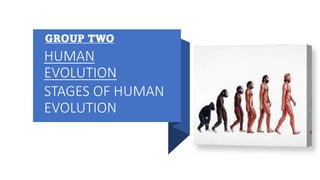
presentation on human evolution
- 2. HUMAN EVOLUTION • Evolution is a slow and gradual process of change in the heritable characteristics of organisms throughout generations. We are now the only living members of what many zoologists refer to as the human tribe, hominins, but there is abundant fossil evidence to indicate that we were preceded for millions of years by other hominins • Some of the factors that affect human evolution are natural selection, genetic drift, migration, climate change, etc. • There are seven major stages of human evolution. They are Ardipithecus ramidus, Australopithecus afarensis, Homo habilis, Homo erectus, Homo heidelbergensis, Homo neanderthals, and Homo sapiens.
- 3. ARDIPITHECUS RAMIDUS • They lived 4.4 million years ago in Ethiopia • They were the most ape-like with a brain size of 300-350cm3 • They were the hairiest among human ancestors and lived in woodlands • Facial anatomy did not exhibit aggressiveness because they had smaller canines and incisors • They exhibit sexual dimorphism in height but lack sexual dimorphism in terms of their canine tooth • They were prognathic meaning the lower teeth rolled over the upper teeth • They had opposable digits for gripping trees(arboreality)
- 4. AUSTRALOPITHECUS AFARENSIS ❖ They existed 3.2 million years ago ❖ They lived in the Pliocene of east Africa ❖ They lived in the woodlands with patches of grassland and exhibited bipedalism ❖ They had a brain size of 450cm3 and better vision to spot predators ❖ Had smaller canines but larger than homo sapiens ❖ Their extinction was due to the severity of drought
- 5. • They existed about 2.3 million years ago and lived in a grassland environment • They had a slightly rounded skull with a brain size of about 610cm3 , the increase in brain size aided them to make their own tools(stone tools) to fight predators • They were the first to make fire • The hole for spinal cord was in the skull base showing they walked on two legs • They had curved finger bones and relatively short legs • They had smaller canines with larger incisors HOMO HABILIS
- 6. ❖ They lived around 250000 years ago and inhabited Africa, Europe, Australia and some parts of Asia especially around rivers ❖ They had larger brains of about 550- 1250cm3 as compared to Homo Habilis and developed more improved tools ❖ They had a large and thick jaw with no chin ❖ They were carnivorous and could cook their own food ❖ They were more populated than homo habilis ❖ Their extinction was due to their laziness HOMO ERECTUS
- 7. ❑ In 1901 the jawbone (maeur) of what is believed to be an archaic species was discovered in Heidelberg, a town in Germany and the species was later named Homo heidelbergensis ❑ They existed around 600000 years ago and lived in temperate regions (cold environments) ❑ They had a short and wide body stature, which helped them to conserve heat ❑ They had a brain size of about 1220- 1300 cm3 and improved upon their tools for hunting ❑ They lived In social groups and built their own shelter and also buried their dead. • •HOMO HEIDELBERGENSIS.
- 8. Heidelbergensis continued; ❑ They exhibited sexual dimorphism ❑ They had thick and broad jaws with small teeth and depended so much on meat ❑ It was deduced by scientist that members of the homo heidelbergensis buried their dead members. This was because many of their fossils were discovered at a particular place together in Spain. ❑ Some of their fossils were discovered with the fossils of predators and this indicates that they fought predators, and some were killed by predators.
- 9. HOMO NEANDERTHALS • They existed around 400000 years ago and were found to inhabit cold steep environments (ice age period) • They had short and wide body stature which aided in heat conservation • They had a very wide nose( made air warm) • They had powerful arms for killing strong animals • They had a long low skull • Were also believed to have the largest brain size (1500-1700cm3) •
- 10. ❑ Homo sapiens are believed to still be in existence till now, they have a large brain size(of about 1350cm3 ) but not larger than H. Neanderthals ❑ They are the most widespread species which inhabit temperate, tropical, tundra, terrestrial, savanna and desert regions ❑ They have rounded brain cases to accommodate the large brain size ❑ They have a small face protracted under the frontal tori ❑ They have less hair HOMO SAPIENS
- 11. THANK YOU